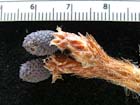
Mature tree [C. J. Earle, 2005.02.08].

Forest of P. lawsonii and P. pseudostrobus var. apulcensis along Hwy 175 in Oaxaca [C. J. Earle, 2005.02.08].

P. lawsonii forest on hillside, valley of Oaxaca beyond [C. J. Earle, 2005.02.08].

Cone in situ [C. J. Earle, 2005.02.08].

Recently fertile pollen cones [C. J. Earle, 2005.02.08].

Crown, crowded with cones [C. J. Earle, 2005.02.08].

First-year seed cones [C. J. Earle, 2005.02.10].

Seed cones [C. J. Earle, 2005.02.08].

Bark on mature tree, and an epiphytic bromeliad [C. J. Earle, 2005.02.08].

Conservation Status

Pinus lawsonii
Roezl ex Gordon et Glendinning 1862
Common names
Pino ortigillo [Spanish].
Taxonomic notes
Syn.: Pinus altamiranoi Shaw in Sargent 1905, Pinus lawsonii Roezl ex Gordon var gracilis Debreczy et Rácz 1995 (Farjon 1998). Type: Mexico, B. Roezl (original material not located). Neotype: Pringle, Michoacan, "hillsides near Uruapan," 1904.10.09 (Farjon and Styles 1997).
Description
Trees to 30 m tall and 75 cm dbh, usually with a single straight trunk and a domed, open, often irregular crown. Bark thin, red-brown, exfoliating in thin plates, with age becoming thick, rough, scaly, black-brown with deep longitudinal fissures and a purplish-red inner bark. Shoots smooth, ridged, orange-brown, often glaucous. Foliar units form dense to open tufts. Fascicle sheaths at first up to 25 mm long, the imbricate scales lustrous orange-brown; persistent but reduced to 10-15 mm long in older fascicles, weathering grey or blackish brown. Leaves in bundles of 3-4(-5), persisting 2-3 years, straight, directed forward to spreading wide, stiff, 12-20(-25) cm x 1-1.2(-1.5) mm, glaucous green, apex acute. Stomata on all faces of the leaves, in (6-)9-12 lines on the convex outer face and 4-5 lines on each inner face. Pollen cones crowded near the basal end of a new shoot, ovoid-oblong to cylindrical, 10-20 x 5-6 mm, yellowish green, turning light brown. Seed cones near base of new shoots, solitary or opposite on stout, curved peduncles up to 10 mm long, which usually fall with the cone. First-year cones purplish red, 10-15 mm long, maturing in second year. Mature cones ovoid when open, with a flattened base, 5-8(-9) x 4-6(-7) cm. Seed scales ca. 70-100, thick woody, dark brown, with two light brown marks of seed wings on the upper side. Apophysis slightly raised, transversely keeled, rhombic. Umbo dorsal, pyramidal, curved, transverse·rhombic, 3-4 x 4-5 mm, grey-brown, without a prickle. Seeds obovoid, flattened, 4-5 mm long, dark brown with a 12-16 mm translucent light brown wing (Farjon and Styles 1997).
Distribution and Ecology
Mexico: Michoacán, México, Morelos, Distrito Federal, Veracruz (one locality), Guerrero, and Oaxaca (Farjon and Styles 1997). See also Thompson et al. (1999).
Distribution data from USGS (1999).
Pinus lawsonii occurs in forest and woodland at 1300-2600 m elevation. Climate is warm-temperate to temperate with 600-1500 mm annual precipitation and a November to May dry season. It grows with various species of Quercus and a variety of other pines including Pinus pringlei. P. patula, P. montezumae, P. oocarpa, P. leiophylla, P. herrerae, P. teocote, and P. pseudostrobus. On sites with sandy, shallow soil, Juniperus can be co-dominant (Farjon and Styles 1997).
Zone 10 (cold hardiness limit between -1°C and +4.4°C) (Bannister and Neuner 2001).
This species is a principal host for the dwarf mistletoes Arceuthobium globosum subsp. grandicaule, A. nigrum, A. oaxacanum, and A. vaginatum subsp. vaginatum (Hawksworth and Wiens 1996).
Remarkable Specimens
Ethnobotany
Observations
Remarks
The epithet honors English plantsman Charles Lawson (1794-1873).
Citations
Gordon, G. 1862. A Supplement to Gordon's Pinetum: containing descriptions and additional synonymes of all the coniferous plants not before enumerated in that work. London (p. 64).
See also









